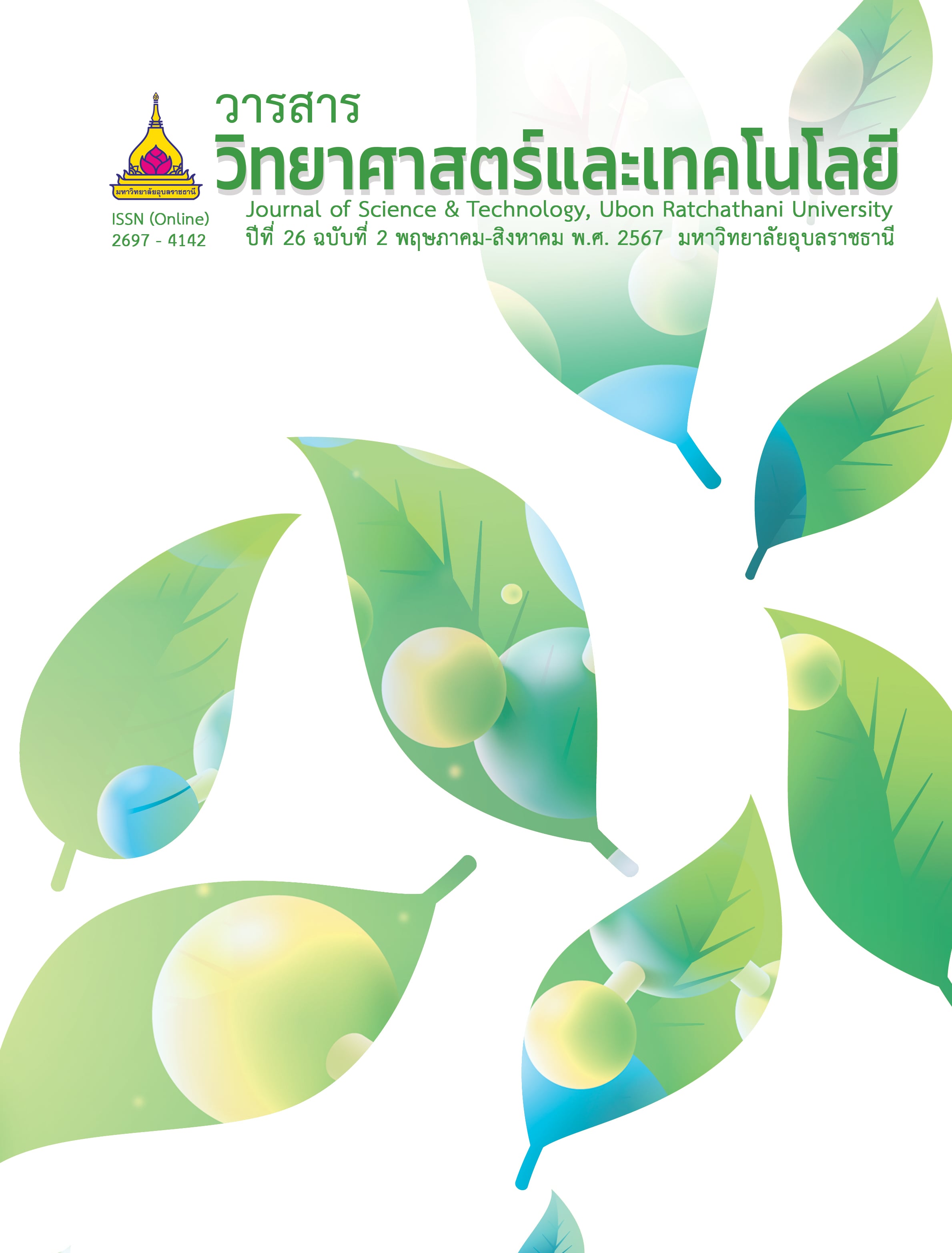ฤทธิ์ต้านอนุมูลอิสระ ฤทธิ์ยับยั้งเอนไซม์ไทโรซิเนส ปริมาณฟีนอลิกรวม และปริมาณฟลาโวนอยด์รวม ของสารสกัดหยาบจากผลและใบสมอไทย
Main Article Content
บทคัดย่อ
งานวิจัยนี้มีวัตถุประสงค์เพื่อทดสอบฤทธิ์ต้านอนุมูลอิสระ และฤทธิ์ยับยั้งเอนไซม์ไทโรซิเนส รวมทั้งวิเคราะห์ปริมาณฟีนอลิกรวม และปริมาณฟลาโวนอยด์รวมของสารสกัดหยาบจากผลสมอไทยและใบสมอไทย ซึ่งสกัดด้วยตัวทำละลาย 3 ชนิด คือ เอทานอลร้อยละ 95 เอทานอลร้อยละ 70 และเอทานอลร้อยละ 50 การทดสอบฤทธิ์ต้านอนุมูลอิสระทำโดยวิธี 2,2-diphenyl-1-picrylhydrazyl radial scavenging capacity assay (DPPH assay), ABTS radical cation decolorization assay (ABTS assay) และ ferric ion reducing antioxidant power (FRAP) assay การทดสอบฤทธิ์ยับยั้งเอนไซม์ไทโรซิเนสทำโดยวิธี Dopachrome method การวิเคราะห์ปริมาณฟีนอลิกรวมทำโดยวิธี Folin-Ciocalteu assay และการวิเคราะห์ปริมาณฟลาโวนอยด์รวมทำโดยวิธี Aluminum chloride colorimetric assay จากการศึกษา พบว่า สารสกัดหยาบจากใบสมอไทยที่สกัดด้วยเอทานอลร้อยละ 95 มีฤทธิ์ต้านอนุมูลอิสระมากที่สุดด้วยวิธี DPPH (IC50 = 8.064±0.19 ไมโครกรัมต่อมิลลิลิตร) และวิธี FRAP assay (FRAP value = 1,238.211±2.47 มิลลิโมลาร์สมมูลของเฟอร์รัสซัลเฟตต่อกรัมสารสกัด) นอกจากนี้ยังพบว่ามีฤทธิ์ยับยั้งเอนไซม์ไทโรซิเนสมากที่สุด (IC50 = 0.327±0.10 มิลลิกรัมต่อมิลลิลิตร) และมีปริมาณฟลาโวนอยด์รวมมากที่สุด (144.183±6.73 มิลลิกรัมสมมูลของเควอซิทินต่อกรัมสารสกัด) ส่วนสารสกัดหยาบใบสมอไทยที่สกัดด้วยเอทานอลร้อยละ 50 มีฤทธิ์ต้านอนุมูลอิสระมากที่สุดด้วยวิธี ABTS assay โดยมีค่าการต้านอนุมูลอิสระ ABTS•+ เท่ากับ 442.405±12.16 มิลลิกรัมสมมูลของวิตามินซีต่อกรัมสารสกัด และมีปริมาณฟีนอลิกรวมมากที่สุด (418.007±19.55 มิลลิกรัมสมมูลของกรดแกลลิกต่อกรัมสารสกัด) การศึกษานี้ชี้ให้เห็นว่าใบสมอไทยถือเป็นแหล่งของสารออกฤทธิ์ทางชีวภาพที่น่าสนใจ ซึ่งอาจเป็นสมุนไพรทางเลือกในการนำไปใช้ประโยชน์ทางด้านเวชสำอาง และวิจัยต่อยอดด้านเภสัชวิทยาเพื่อการพัฒนาเป็นสารออกฤทธิ์ทางยาต่อไป
Article Details

อนุญาตภายใต้เงื่อนไข Creative Commons Attribution-NonCommercial-NoDerivatives 4.0 International License.
บทความที่ได้รับการตีพิมพ์เป็นลิขสิทธิ์ของ วารสารวิทยาศาสตร์และเทคโนโลยี มหาวิทยาลัยอุบลราชธานี
ข้อความที่ปรากฏในบทความแต่ละเรื่องในวารสารวิชาการเล่มนี้เป็นความคิดเห็นส่วนตัวของผู้เขียนแต่ละท่านไม่เกี่ยวข้องกับมหาวิทยาลัยอุบลราชธานี และคณาจารย์ท่านอื่นๆในมหาวิทยาลัยฯ แต่อย่างใด ความรับผิดชอบองค์ประกอบทั้งหมดของบทความแต่ละเรื่องเป็นของผู้เขียนแต่ละท่าน หากมีความผิดพลาดใดๆ ผู้เขียนแต่ละท่านจะรับผิดชอบบทความของตนเองแต่ผู้เดียว
เอกสารอ้างอิง
Phansawan, B. 2014. Free radicals, antioxidants and antioxidant activity determination. Thai Science and Technology Journal. 21(3): 275-286. (in Thai)
Thaenkham, A. and Padumanonda, T. 2019. The effectiveness and side effects of Ya Thor-Ra-Nee-San-Tha-Kat compared to naproxen tablets for the reduction of oxidative stress in patients with myofascial pain syndromes. Huachiew Chalermprakiet Science and Technology Journal. 5(1): 17-29. (in Thai)
Gupta, P.C. 2012. Biological and pharmacological properties of Terminalia Chebula Retz. (Haritaki) -An overview. International Journal of Pharmacy and Pharmaceutical Sciences. 4(3): 62-68.
Saenprakob, P. and Saengmanee, K. 2020. Development of facial cleansing anti-acne gel formulation using Terminalia chebula extract. Wichcha Journal Nakhon Si Thammarat Rajabhat University. 39(2): 87-100. (in Thai)
Buachoon, N. and et al. 2018. Antioxidant activity of crude extract from Terminalia Chebulia. VRU Research and Development Journal Science and Technology. 13(2): 98-107. (in Thai)
Arya, A. 2012. Antioxidant and hypoglycemic activities of leaf extracts of three popular Terminalia Species. E-Journal of Chemistry. 9(2): 883-892.
Nittayajaiprom, W. and et al. 2014. Mutagenicity, antimutagenicity and tyrosinase inhibition activity of hydroglycol extracts from Terminalia chebula Retzius, Terminalia bellerica Roxb and Rafflesia kerrii Meijer. International Journal of Phytomedicine. 6 (1): 93-102.
Prompamorn, P. and Ratcharin, N. 2016. Evaluation of antibacterial activity and gel formulation development from Terminalia chebula Retz extract. SDU Research Journal Science and Technology. 9(1): 51-63. (in Thai)
Chewchinda, S., Kongkiatpaiboon, S. and Sithisarn, P. 2019. Evaluation of antioxidant activities total phenolic and total flavonoid contents of aqueous extracts of leaf, stem, and root of Aerva lanata. Chiang Mai University Journal of Natural Sciences. 18(3): 345-357.
Srisorn, P. and et al. 2020. Effect of frozen storage on quality of Chormuang dough contains pregelatinized Hom Nil flour. Journal of Science and Technology, Ubon Ratchathani University. 22(3): 92-102. (in Thai)
Benzie, I.F.F. and Strain, J.J. 1996. The ferric reducing ability of plasma (FRAP) as a measure of ‘‘Antioxidant Power’’: The FRAP assay. Analytical Biochemistry. 239: 70-76.
Itsarasook, K. 2015. Free radical scavenging and tyrosinase inhibitory activity of Longkong leaves extract. SDU Research Journal Science and Technology. 8(3): 81-96. (in Thai)
Dunkhunthod, B. and Sittisart, P. 2022. Antioxidant activity and cytotoxicity against human cancer cell lines of the aqueous leaf extracts of Smilax luzonensis, Hoya kerrii and Derris elliptica. Journal of Science and Technology, Ubon Ratchathani University. 24(2): 1-11. (in Thai)
Sithisarn, P. and et al. 2015. Antioxidant activity and antibacterial effects on clinical isolated Streptococcus suis and Staphylococcus intermedius of extracts from several parts of Cladogynos orientalis and their phytochemical. Evidence-Based Complementary and Alternative Medicine. (1-2): 908242.
Paduka, W. and et al. 2021. Determination of active constituents and antioxidant activity of Premna trichostoma Miq. leaf extract. RMUTP Research Journal. 15(2): 118-129. (in Thai)
Halee, A. and Rattanapun, B. 2017. Study of antioxidant efficacies of 15 local herbs. KMUTT Research & Development Journal. 40(2): 283-293. (in Thai)
Cock, I. 2015. The medicinal properties and phytochemistry of plants of the genus Terminalia (Combretaceae). Inflammopharmacology. 23: 203-229.
Singh, A. and et al. 2016. Comparative profiling of phenolic compounds from different plant parts of six Terminalia species by liquid chromatography–tandem mass spectrometry with chemometric analysis. Industrial Crops and Products. 87: 236-246.
Rastogi, S. 2017. Phytochemical analysis, phenolic content and antioxidant properties of different parts of Terminalia bellirica (Gaertn.) Roxb. - A comparative study. Indian Journal of Traditional Knowledge. 17(2): 370-375.
Pietta, P.G. 2000. Flavonoids as antioxidants. Journal of Natural Products. 63: 1035-1042.
Kim, Y.J. and Uyama, H. 2005. Tyrosinase inhibitors from natural and synthetic source: structure, inhibition mechanism and prospective for the future. Cellular and Molecular Life Sciences. 62: 1707-1723.
Solano, F. and et al. 2006. Hypopigmenting agents: An updated review on biological, chemical and clinical aspects. Pigment Cell Research. 19: 550-571.
Ebanks, J.P., Wickett, R.R. and Boissy, R.E. 2009. Mechanisms regulating skin pigmentation: The rise and fall of complexion coloration. International Journal of Molecular Sciences. 10(9): 4066-408.


